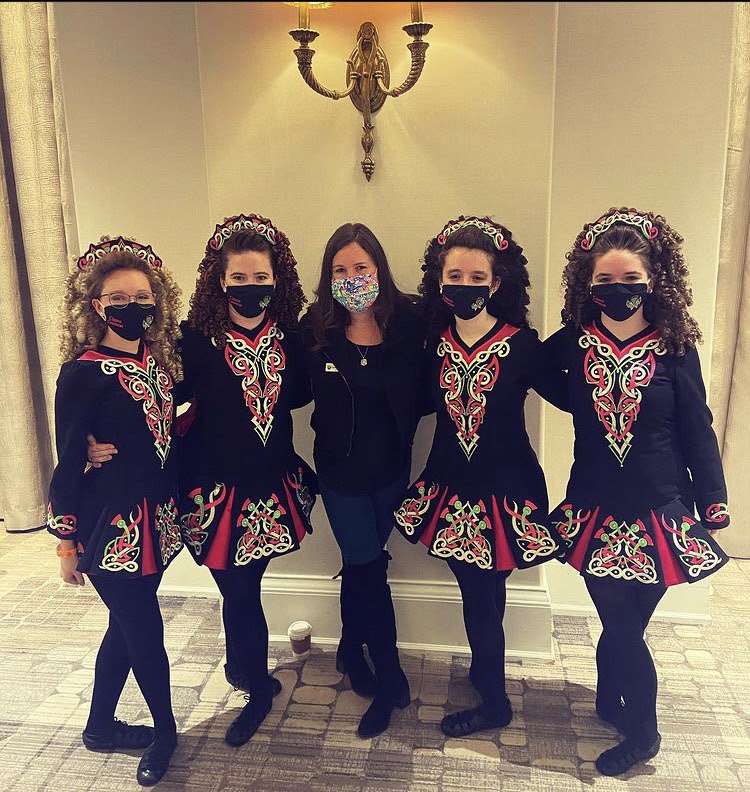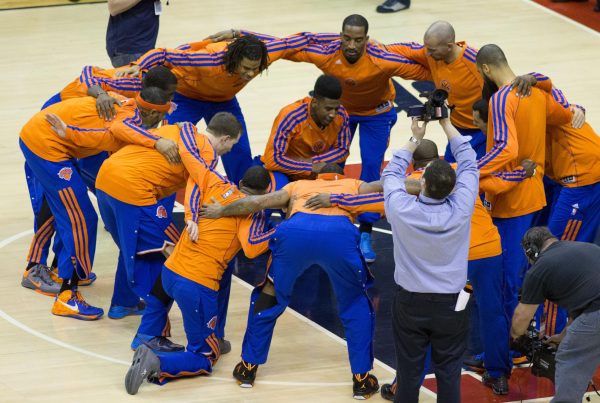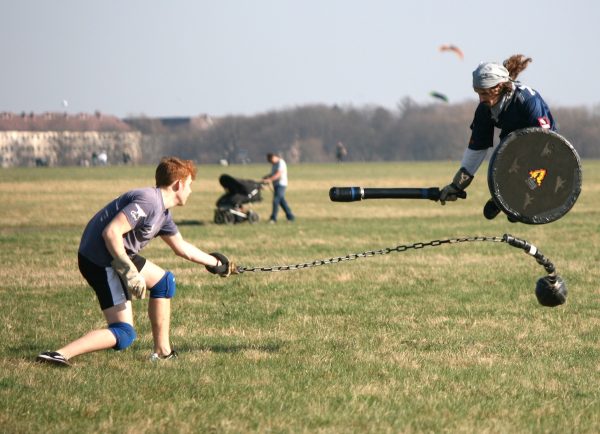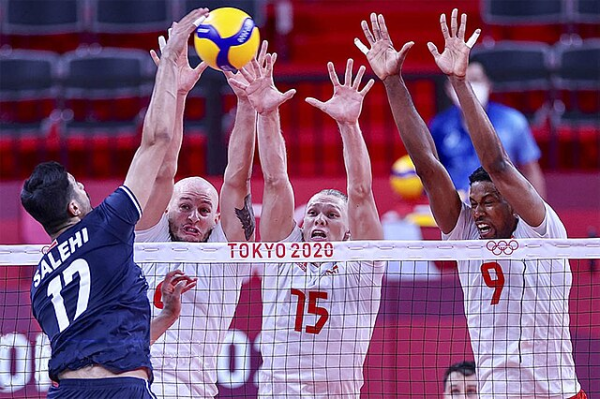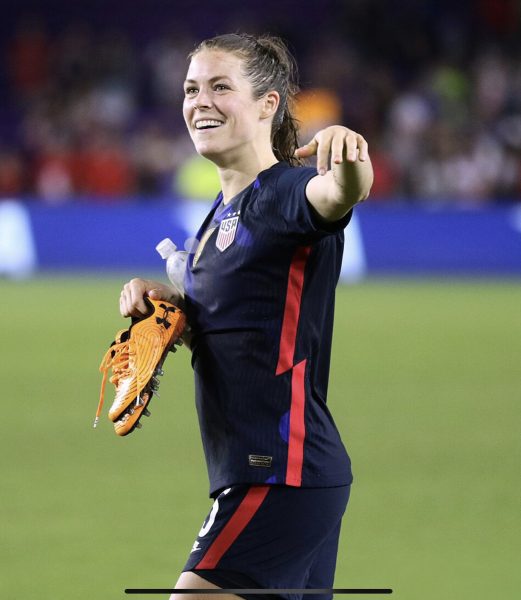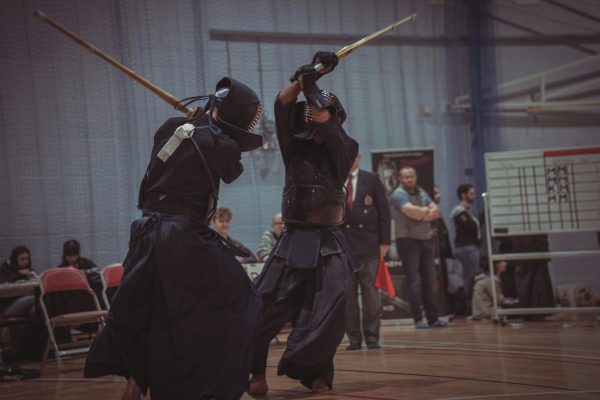From Rags to Wigs: The Evolution of Irish Step Dancing
Since Irish Dancing’s (potential) origins in the 1700s, the world has evolved into a completely different place, and Irish Dancing has had to evolve with it.
A picture displaying some dancers wearing their competition dresses alongside Kaitlyn wigs.
“Kick Higher. Turn out. Most importantly, keep your arms in.” One hears this phrase echoing about a dance studio, ordered by a dance instructor. These words are thoroughly ingrained into the movements of any Irish Dancer, including myself, but the art of Irish Dance has drastically changed over the years.
According to my grandmother, who danced for 68 years, and the many grainy black and white videos that I have watched of old Irish dance competitions, modern Irish Step Dancing is far removed from what it was in the early days.
“It’s so fast nowadays. You see those dancers in Ireland and they move so fast,” she said. “It used to be much slower,” she told me.
This sport has developed a greater focus on athleticism over the years. Do you remember those kicks I mentioned earlier? They were practically nonexistent back in the 1920s. It used to be much more about the footwork, about being a grounded dancer as opposed to feet flying through the air. It used to be, as my grandmother put it, “much more boring.”
My dance teacher — Ciara Greene, who has taught for nearly a decade — often during dance class talked about the British colonization of Ireland. This colonization resulted in the widespread ban of Irish culture.
In an attempt to keep the art form alive, dance teachers would travel all over Ireland, teaching the then outlawed dance in secret. Ms. Greene credits this as a reason for the slower style of early Irish Step Dancing. These teachers would supposedly say, “Keep your arms by your side and do not move a lot, so it looks like you are walking.”
The story about pretending that you are walking is one theory, but there are also many darker (and most likely more accurate) theories regarding it. Another story passed down over the centuries is that, due to the Catholicism heavily present in Ireland at the time, dancers had to look like they were having the least amount of fun possible — so no smiling, no slouching, and definitely no swinging your arms. Again, all of these theories are mere speculation with little to no evidence to back them up.
Alongside the banning of Irish culture came the loss of it. Under British rule, the Irish were treated brutally, such as being beaten for speaking their native tongue so that they would only speak English, or having their main supply of food, potatoes, being shipped out of Ireland to Britain during a period where Irish people were already starving.
Some problems in Irish Dancing have remained prevalent throughout its history, most notably a deep-seated classism which has plagued the art form since its beginnings.
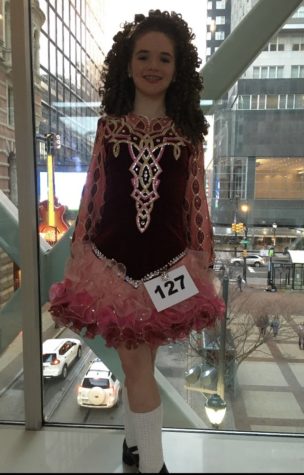
My grandmother, who grew up on a farm in Ireland, recalled the treatment she faced by townspeople. She said, “When you’d come into town for the feises [a traditional Gaelic arts and culture festival], the people never wanted you there. They didn’t like your shoes. ‘Hicks’ — that’s what they would call us.”
A more recent experience comes from Claire Spinetti — an Irish dancer for 23 years — who shared an experience concerning a girl with whom she used to dance. “She received notes on her dancing, and one of them was that she was wearing an ‘outdated dress’ because she was wearing a family heirloom dress.” Spinetti said, “It was actually really sad because I think she stopped dancing after that.”
This ties into a criticism Spinetti has about today’s trends in dancing dresses. “When I first started dancing, the dresses were all about history and tradition…where there are now trends and you can be wearing something ‘out of style’ because the collective decided something else was the new ‘in’ thing,” she continued.
These trends are most commonly seen in various Irish Dancing competitions. You have a feis (pronounced fesh) which is a more local dance competition. Then there is an Oireachtas (pronounced oh-ROCK-tus) which is a regional competition in your country. Then there are Nationals and Worlds, which are self explanatory.
According to Spinetti, and many dancers like her, Irish Dancing was never supposed to be about the glitz and glam of the dresses, a superficial element of a beautiful tradition. It’s about connecting with Irish culture, and engaging with a form of art that has gone through similar lengths as ‘The Odyssey’ to be passed down.
Not only does putting such an emphasis on this aspect detract from what dancing is all about, that being the actual sport, but it also decreases the accessibility of Irish Dancing. This pressures dancers to pour their funds into thousand-dollar dresses and hundred dollar wigs, to buy whatever dance bag is trendy at the moment only for it to go out of style a couple years later.
The wigs themselves are almost a mutation of tradition. In the origins of feises, girls would go to their competitions wearing their Sunday best and curling their hair in rags and beer the night before.
As this form of dancing spread to America, the inconvenience of sleeping in curlers the night before a competition was noted and led to the business of wearing wigs to competitions instead. Wig-wearing became the norm and with it came dozens of different styles of wigs.
For example, there is the bun wig, which is a comparatively smaller wig with big ringlets. For many dancers, the convenience of this wig is outweighed by the pressure to transfer to a bigger wig as they move up the ranks. One example of a bigger wig would be the Kaitlyn wig, which has very long and tight ringlets and practically swallows up your whole head.
All of this focus on tradition may seem silly, but it is understandable in the context of Irish history. Ireland faced cultural genocide from the British, turning all of their once joyful expressions of self and culture into illicit, back-alleyway deeds. Many forms of Irish culture were forbidden, including speaking Irish Gaelic, which led to the death of the language.
My grandmother is the only Irish person she knows who can speak a lick of Irish Gaelic, and it would be very difficult now to resurrect the language. The people of Ireland had to hold onto their culture tightly during this time, with much of it slipping through their fingers.
For many, their experience with Irish Dancing is the only thread left tying them to their culture, with dancer Mary Kirk saying, “The only reason I know anything about Irish culture is because of Irish Dancing.”
Irish Dancing is one of the only pieces of original Irish culture left, and most of the details on it are hazy. There is no sure date as to its origin. Many of the traditional dances vary depending on who is doing it, and, most importantly, nobody knows why you dance with your hands by your sides.
There is no way of knowing for sure, so it makes sense that many Irish Step Dancing judges and dancers are such sticklers for tradition. While it is important to stay true to tradition, it is also important for it to adapt to the change of the times so that it does not have to face the slow and painful death it once evaded.
For many, their experience with Irish Dancing is the only thread left tying them to their culture, with dancer Mary Kirk saying, “The only reason I know anything about Irish culture is because of Irish Dancing.”
Monica Reilly is an Editor-in-Chief for ‘The Science Survey.' She has always loved using the art of journalism to educate and connect with people. She...

